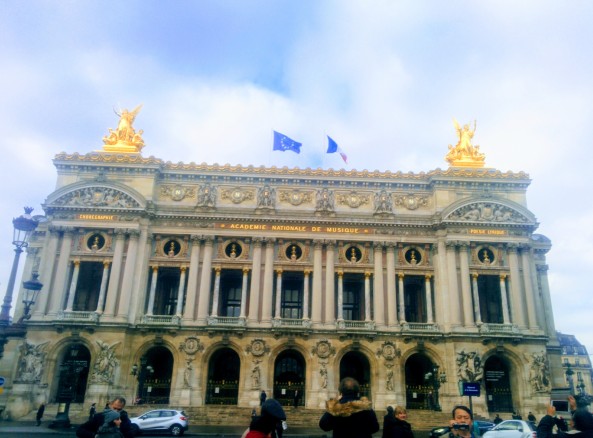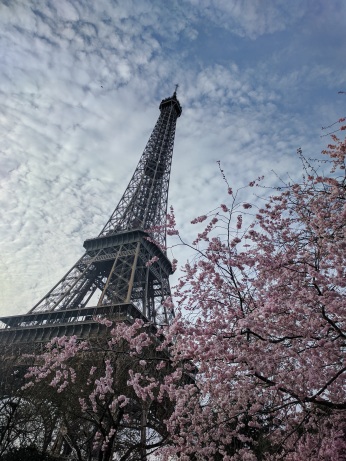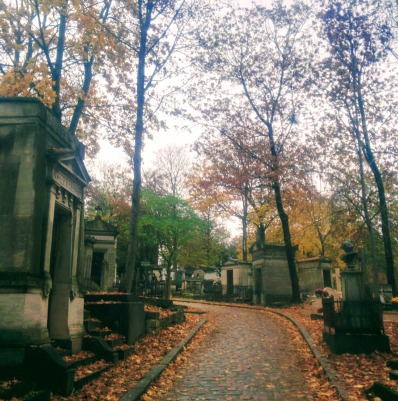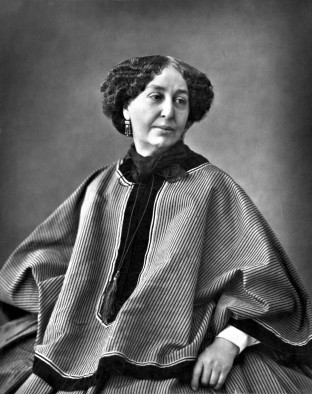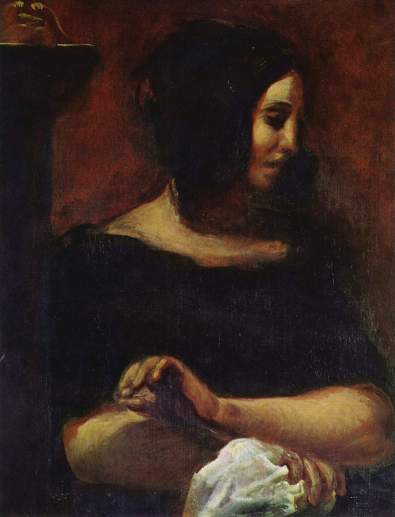If you’re anything like me, visiting a foreign city is an excuse to gorge yourself on all the local favourites, in the name of ‘experiencing culture’. Sadly, when you’re travelling alone or on a budget, and in a limited time frame, it can be hard to find an obliging grandmother to cook you all the traditional meals you read about, and with the added barriers of language and not knowing the area, it’s hard to figure out how to sample local delicacies without paying too much or ending up in total tourist traps. Fortunately, I’ve spent enough time living in Paris whilst being simultaneously very poor and very interested in eating well to give you the low-down on what those Parisians are really eating, and how much you should be paying for it. Even if you’ve only got one weekend, you should be able to try most of these French favourites, without wincing too much at the state of your wallet afterwards.
Viennoiseries
Being perhaps what France is best known for, it only makes sense to start off a trip in Paris with viennoiseries – what you’d probably call pastries. The traditional croissant is a firm favourite, frequently eaten with nothing by way of accompaniment except perhaps some steaming espresso coffee. But if you’re seeking something a little sweeter, branch out and try a pain au chocolat (aka a chocolate croissant for us Anglospeakers), croissant aux amandes (a croissant filled with a sweet pastry cream made with almond meal and covered by finely sliced almonds), chausson aux pommes (rather like an apple turnover), or, if you’re game, a pain Suisse, which combines the sweet pastry cream of croissant aux amandes with small chunks of chocolate to give you plenty of sugary energy for your day.
Find these sweet treats and more at a boulangerie – most also sell coffee and hot drinks, and may offer mini-formules that let you buy one viennoiserie and one coffee at a reduced price. Try to avoid chains like Paul’s, La Croissanterie or Pomme de Pain, and if you’re staying outside of the actual city don’t hesitate to stop by the local boulangerie before heading to Paris for the day.
Prices: 90c (for a croissant or pain au chocolat) to 2 euros, 2-3 euros with espresso coffee
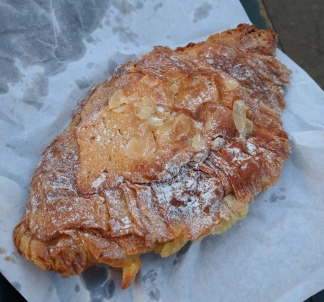
Croissant aux amandeé
Crêpes
Perfect for breakfast, lunch or just a snack, crêpes are a go-to food for many travellers and native Parisians alike. Generally available in a wide range of both sweet and savoury varieties, they’re a cheap and warming way to fill your stomach whilst on the move. For a savoury snack, opt for jambon-fromage (ham and cheese, usually either cheddar or Emmental) or swap out the ham for oeuf (egg), poulet (chicken) or thon (tuna). If you’ve got a sweet tooth, sucre (sugar) and Nutella crepes are probably the most commonly appreciated, but it’s worth trying crème de marron (chestnut cream) or caramel au beurre salé (salted butter caramel) for a really French taste. Personally, I can never resist a Speculoos crêpe if I see it on the menu!
Crêpe stands abound throughout the city, wherever you might be. They’re also sold in restaurants, but I find it more fun – and cheaper – to watch them make it in front of me at a stand or small specialised shop. Specialised restaurants called crêperies are also plentiful, and offer more choice plus warm interiors. They often have formules which include one savoury crepe, called a galette, one sweet crepe, and a drink – be sure to try cider, if it’s on the menu, as it’s the most traditional accompaniment.
Prices: from 2 euros (crepe au sucre) to 8 euros (if you’re getting something with lots of fillings), 8 to 15 euros for a formule at a crêperie
Baguette Sandwich
Sometimes the thought of a crepe, dripping with melted cheese or oozing sugary spread, while delicious, sounds altogether a little too rich. Fortunately, if it’s still lunch on the go you’re looking for, Paris has a perfect alternative: the baguette sandwich. Made either on custom-baked rolls nearly a foot long, or simply on a baguette sawn neatly in half, they provide a convenient way to consume some good French bread and can be stowed in a bag to be eaten while queuing for a museum, or in one of the many public parks that throng the city. Fillings range from the simple, with just one star ingredient complimented by beurre (butter), to more complex concoctions. If you’re after something traditional, choose combinations including your favourites from below:
Jambon (ham)
fromage (cheese)
saucisse (salami)
camembert
chèvre (goat’s cheese)
mozzarella
tomates (tomatoes
crudites (fresh salad ingredients, usually lettuce and tomato)
poulet (chicken)
thon (tuna)
saumon (smoked salmon)
These satisfying sandwiches are sold in the same places as viennoiseries, the ubiquitous boulangerie, but in smaller shops are not always displayed, rather made fresh upon request. Look for the word ‘sandwich’ if you can’t see rows of them lined up in the glass window. Formules are frequently available, usually consisting of a sandwich, a drink and a sweet – listed as ‘dessert’, or sometimes ‘patisserie’.
Prices: 3 euros (for single-ingredient) to 6 euros (unless you’ve gone somewhere very fancy), 5 to 11 euros for a formule

Sandwich saumon-crudités

Sandwich chèvre-noix
Pastries (Patisseries)
Now, what would Paris be without its famous patisseries? From the Paris-Brest to the macaron, from the sumptuous Royale to the humble éclair…it would almost be a sin to stop in Paris without sampling at least one of these delicate, rich treats. There’s an almost limitless variety to be found, whether glinting with gold-leaf in patisseries on Avenue de l’Opèra, or simply neatly arranged in a back-street local store, but a few crowd-pleasers are almost sure to be among the ranks in every display. The big sister of the éclair is the religieuse (this translates as ‘nun’, being what the little desserts are supposed to resemble), offering the same sweet custard encased by crisp choux pastry. Mille-feuille is a good option for the wary, but not the weak-hearted: layers of thick custard, pastry and sugar make it delicious but nothing that can be described as light. The Paris-Brest was named in honour of the race of the same name, and consists of delicate praline cream with a crunchy pastry exterior. To round off the Paris-centric cakes there’s the Royale (sometimes known as Trianon, being named after the miniature palace at Versailles), perfect for chocolate lovers with its layers of chocolate mousse, chocolate ganache and crisp dacquoise (a meringue-like substance made with almonds) while those preferring the rich flavour of coffee can opt for an opèra, named for the famous Opèra Garnier and involving multiple levels of coffee-soaked sponge cake and chocolate.
Patisseries, confusingly or conveniently enough, are found at patisseries, made by patissiers. Most boulangeries are combined boulangerie-patisseries and as such it’s child’s play to find one, but look out for a salon de thé if you seek the creature comforts of warmth, a table to eat your pastry at and perhaps a pot of tea. It may cost a little more to eat in, but the extra fraction is well worth it on wintry days!
Prices: usually 2.20 euros to 5 euros, though at the big names like Lenôtre or Angelina’s expect something in between 6 and 10 euros. Yes, for one pastry.

Lilas (macaron with mascarpone filling)

Paris-Brest (choux pastry with praline cream filling)

Religeuse au chocolat (filled with chocolate pastry cream)

Fleur noir (layers of chocolate mousse and biscuit)

Eclair au chocolat

Printanier (pistachio cream with fresh strawberries)
This slideshow requires JavaScript.
Déjeuner Formule
If you’ve got the time, money and appetite for a full French meal, be sure to take advantage of the numerous formule déjeuner (lunch menus) available. Some, unfortunately, run only on weekdays, but many restaurants still offer them on weekends. Their form can vary slightly: the basic premise is that you pay a lower price for a fixed menu, choosing from combinations of entrée-plat (starter and main), plat-dessert (main and dessert) or all three (for a higher price, of course). Sometimes there are multiple options for each dish, and sometimes you get the plat du jour (meal of the day) with no choice about it. They’re a great way to sample some of the French classics, but if you’ve splashed out on three courses, take your time – the rich food, even when offset by the basket of complimentary bread, calls for tranquil, languid dining habits.
Look out for:
soupe à l’oignon (onion soup served with a crust of bread and melted Gruyere cheese)
escargots à la bourguignon (Burgundy style snails served with garlicky sauce)
salade au chèvre (salad served with goats cheese, generally drizzled with honey)
oeufs à la mayonnaise (devilled eggs)
cuisse de canard or confit de canard (duck thigh cooked in traditional style)
boeuf bourguignon (traditional beef stew originating from Burgundy, like the snails)
crème brulée (super thick vanilla custard covered by a layer of caramelised sugar)
fromage blanc or fromage à la campagne (soft white cheese the consistency of thick yoghurt, often eaten with sugar or jam on top)
assiette de fromage (cheese plate)
mousse au chocolat (rather easy to guess, but very traditionally French)
Restaurants with formule-déjeuners are found all over Paris, but prices and quality will vary hugely according to your location. For budget travellers, go ahead and try Montmartre or the Latin Quarter for 10 euro menus aimed at tourists, but be aware that your servings will be small and the quality questoinable. Otherwise, venture out to less popular suburbs such as Belleville (19th/20th arrondissement) or anywhere outside the arrondissements of Paris.
Prices: starting at 10 euros for entrée-plat-dessert, but average prices hovering around 15 for two courses.

Oeufs à la mayonnaise
Planche fromage/charcuterie/mixte
Paris is host to an innumerable quantity of bars, brasseries and other drinking establishments, many of which provide food as well as endless aperol spritzers. When out for a drink, the best choice for something to nibble on alongside your wine is indubitably a planche (board). Generally found in three types – fromage (cheese), charcuterie (cold deli meats) or mixte (both cheese and meat), the servings are usually generous and the bread plentiful.
Consult almost any menu in a bar or brasserie serving meals – they’re often listed under its own heading, A Partager (to share).
Prices: 10 – 20 euros
Chocolat à l’ancienne et glace à l’italienne
Depending on the season, you may well have need to warm yourself up with a good hot drink or find something to refresh you after long treks down cobbled streets. Accordingly, grab yourself a chocolat chaud à l’ancienne (old-fashioned hot chocolate) to discover the real difference between hot cocoa and hot chocolate: one’s chocolatey flavoured milk, the other feels like you’re drinking melted chocolate. Sometimes sold by chocolatiers (especially chains like Chocolat de Neuville), but also found in cafes and salons de thé, these can be a dessert all by themselves. Chocolat chaud onctueux is another name for the same thing – but just glance behind the counter: if you can see the whirling vat of warm chocolate, you know you’re in the right place.
Alternatively, if the weather’s warmer, cool down with glace à l’italienne (Italian-style ice cream). Soft serve ice cream is hugely popular in the warmer months, and available in far more flavours than boring old vanilla, such as salted caramel, strawberry and pistachio. Often, the machines will allow you to combine two flavours for a beautiful – and delicious – colour contrast. Seen only once the sun shows its face, the machines pop up in boulangeries and chocolatiers (chocolate makers) or can be found on the street, especially in busy areas.
Prices: for ice creams, 2.50 euros to 6 euros (for larger sizes). For chocolat chaud, 3 euros (takeaway) to 9 euros (check out Angelina’s for their famous African hot chocolate, coming in at a neat 8.20 euros)

Glace à l’italienne choco-vanille
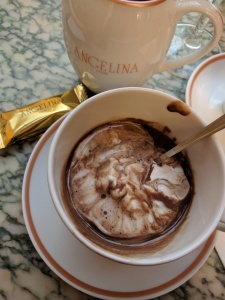
Chocolat chaud à l’ancienne chez Angelina’s
A word of advice: if you want to profit from all that Paris has to offer in terms of gastronomic delights, you won’t be leaving the City of Lights feeling the least bit light – but I promise it’s worth it!




